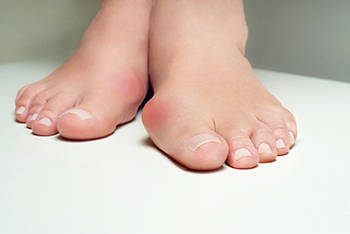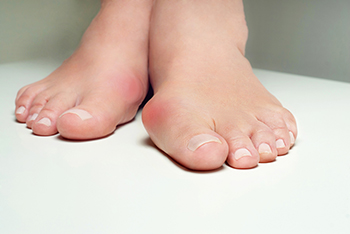Bunion Facts

Bunions are a common foot deformity that can affect both men and women, although they are more prevalent in women who wear narrow-toed shoes. This condition involves the displacement of the joint connecting the big toe and the first metatarsal bone, causing the joint to protrude on the inner side of the foot and the big toe to deviate toward the smaller toes. Several factors contribute to the development of bunions. Genetics may play a role, as there can be a family tendency for this deformity. Abnormal foot mechanics, such as overpronation, where the foot flattens excessively and turns outward during walking, can contribute to bunion formation. Wearing tight, high-heeled shoes can worsen the condition, leading to pain due to shoe pressure and altered weight distribution. Treatment options may include medication for pain relief, protective measures to reduce pressure on the area, and orthotic devices to correct abnormal gait and prevent further deformity. In cases where deformity is severe and conservative treatments are ineffective, surgical intervention may be necessary. If you have a bunion and it is causing discomfort, it is suggested that you make an appointment with a podiatrist who can examine your foot and recommend the most suitable treatment plan.
If you are suffering from bunion pain, contact one of our podiatrists of Family Foot & Ankle Centers. Our doctors can provide the care you need to keep you pain-free and on your feet.
What Is a Bunion?
Bunions are painful bony bumps that usually develop on the inside of the foot at the joint of the big toe. As the deformity increases over time, it may become painful to walk and wear shoes. Women are more likely to exacerbate existing bunions since they often wear tight, narrow shoes that shift their toes together. Bunion pain can be relieved by wearing wider shoes with enough room for the toes.
Causes
- Genetics – some people inherit feet that are more prone to bunion development
- Inflammatory Conditions – rheumatoid arthritis and polio may cause bunion development
Symptoms
- Redness and inflammation
- Pain and tenderness
- Callus or corns on the bump
- Restricted motion in the big toe
In order to diagnose your bunion, your podiatrist may ask about your medical history, symptoms, and general health. Your doctor might also order an x-ray to take a closer look at your feet. Nonsurgical treatment options include orthotics, padding, icing, changes in footwear, and medication. If nonsurgical treatments don’t alleviate your bunion pain, surgery may be necessary.
If you have any questions, please feel free to contact one of our offices located in Corsicana, Ennis, and Waxahachie, TX . We offer the newest diagnostic and treatment technologies for all your foot care needs.
Read more about What Are Bunions?
The information provided in this article is not meant to be medical advice and is for educational purposes only. If you would like to learn more about topics related to podiatry, feel free to contact Family Foot & Ankle Centers by clicking here or calling 972-597-4132 to reach our Waxahachie office, 903-872-9910 to reach our Corsicana office, or 972-875-3668 to reach our Ennis office.



